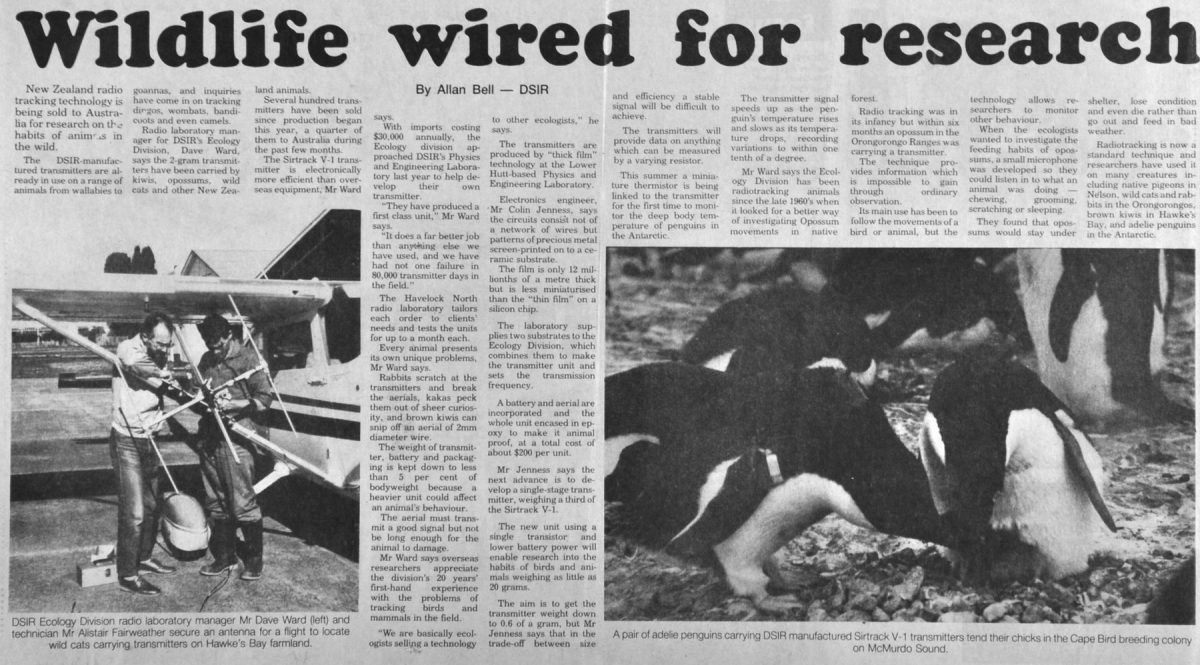Wildlife wired for research
By Allan Bell – DSIR
New Zealand radio tracking technology is being sold to Australia for research on the habits of animals in the wild.
The DSIR manufactured transmitters are already in use on a range of animals from wallabies to goannas, and inquiries have come in on tracking dingos, wombats, bandicoots and even camels.
Radio laboratory manager for DSIR’s Ecology Division, Dave Ward, says the 2-gram transmitters have been carried by kiwis, opossums, wild cats and other New Zealand animals.
Several hundred transmitters have been sold since production began this year. a quarter of them to Australia during the past few months.
The Sirtrack V-1 transmitter is electronically more efficient than overseas equipment, Mr Ward says.
With imports costing $30,000 annually, the Ecology division approached DSIR’s Physics and Engineering Laboratory last year to help develop their own transmitter.
“They have produced a first class unit,” Mr Ward says
“It does a far better job than anything else we have used, and we have had not one failure in 80,000 transmitter days in the field.”
The Havelock North radio laboratory tailors each order to clients’ needs and tests the units for up to a month each.
Every animal presents its own unique problems, Mr Ward says.
Rabbits scratch at the transmitters and break the aerials. kakas peck them out of sheer curiosity. and brown kiwis can snip off an aerial of 2mm diameter wire.
The weight of transmitter, battery and packaging is kept down to less than 5 per cent of bodyweight because a heavier unit could affect an animal‘s behaviour.
The aerial must transmit a good signal but not be long enough for the animal to damage.
Mr Ward says overseas researchers appreciate the division’s 20 years’ first-hand experience, with the problems of tracking birds and mammals in the field.
“We are basically ecologists selling a technology to other ecologists.” he says.
The transmitters are produced by ”thick film” technology at the Lower Hutt-based Physics and Engineering Laboratory.
Electronics engineer, Mr Colin Jenness. says the circuits consist not of a network of wires but patterns of precious metal screen-printed on to a ceramic substrate.
The film is only 12 millionths of a metre thick but is less miniaturised than the “thin film” on a silicon chip.
The laboratory supplies two substrates to the Ecology Division, which combines them to make the transmitter unit and sets the transmission frequency.
A battery and aerial are incorporated and the whole unit encased in epoxy to make it animal proof, at a total cost of about $200 per unit.
Mr Jenness says the next advance is to develop a single-stage transmitter. weighing a third of the Sirtrack V-1.
The new unit using a single transistor and lower battery power will enable research into the habits of birds and animals weighing as little as 20 grams.
The aim is to get the transmitter weight down to 0.6 of a gram, but Mr Jenness says that in the trade-off between size and efficiency a stable signal will be difficult to achieve.
The transmitters will provide data on anything which can measured by a varying resistor.
This summer a miniature thermistor is being linked to the transmitter for the first time to monitor the deep body temperature of penguins in the Antarctic.
The transmitter signal speeds up as the penguin’s temperature rises and slows as temperature drops, recording the variations to within one tenth of a degree.
Mr Ward says the Ecology Division has been radio tracking animals since the late 1960’s when it looked for a better way of investigating Opossum movements in native forest.
Radio tracking was in its infancy but within six months an opossum in the Orongorongo Ranges was carrying a transmitter.
The technique provides information which is impossible to gain through ordinary observation.
Its main use has been to follow the movements of a bird or animal, but the technology allows researchers to monitor other behaviour.
When the ecologists wanted to investigate the feeding habits of opossums, a small microphone was developed so they could listen in to what a animal was doing – chewing, grooming, scratching or sleeping.
They found that opossums would stay under shelter, lose condition and even die rather than go out and feed in bad weather.
Radiotracking is now a standard technique and researchers have used it on many creatures including native pigeons in Nelson, wild cats and rabbits in the Orongorongos, brown kiwis in Hawke’s Bay, and adelie penguins in the Antarctic.
Photo caption – DSIR Ecology Division radio laboratory manager Mr Dave Ward (left) and technician Mr Alistair Fairweather secure an antenna for a flight to locate wild cats carrying transmitters on Hawke’s Bay farmland.
Photo caption – A pair of adelie penguins carrying DSlR manufactured Sirtrack V-1 transmitters tend their chicks in the Cape Bird breeding colony on McMurdo Sound.












Do you know something about this record?
Please note we cannot verify the accuracy of any information posted by the community.